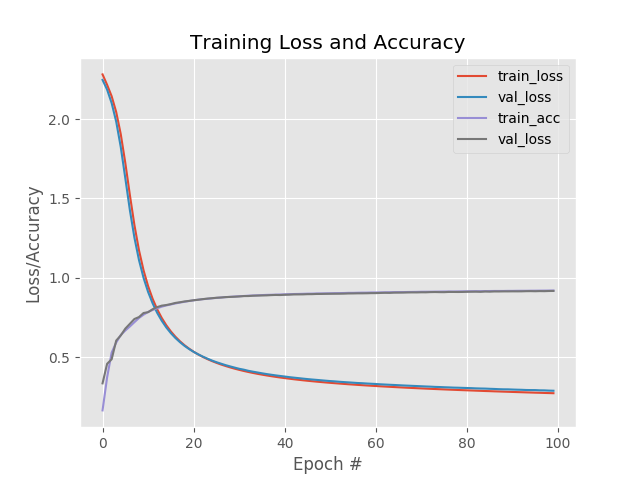Keras实现MNIST分类
仅仅为了学习Keras的使用,使用一个四层的全连接网络对MNIST数据集进行分类,网络模型各层结点数为:784: 256: 128 : 10;
使用整体数据集的75%作为训练集,25%作为测试集,最终在测试集上的正确率也就只能达到92%,太低了:
precision recall f1-score support
0.0 0.95 0.96 0.96 1721
1.0 0.95 0.97 0.96 1983
2.0 0.91 0.90 0.91 1793
3.0 0.91 0.88 0.89 1833
4.0 0.92 0.93 0.92 1689
5.0 0.87 0.86 0.87 1598
6.0 0.92 0.95 0.94 1699
7.0 0.94 0.93 0.93 1817
8.0 0.89 0.87 0.88 1721
9.0 0.89 0.90 0.89 1646
micro avg 0.92 0.92 0.92 17500
macro avg 0.91 0.92 0.91 17500
weighted avg 0.92 0.92 0.92 17500
训练过程中,损失和正确率曲线:

上面使用的优化方法是SGD,下面在保持所有参数不变的情况下,使用RMSpro进行优化,最后的结果看起来好了不少啊达到98%:
precision recall f1-score support
0.0 0.99 0.99 0.99 1719
1.0 0.99 0.99 0.99 1997
2.0 0.99 0.97 0.98 1785
3.0 0.97 0.98 0.97 1746
4.0 0.98 0.98 0.98 1654
5.0 0.97 0.97 0.97 1556
6.0 0.99 0.99 0.99 1740
7.0 0.98 0.97 0.98 1845
8.0 0.97 0.98 0.97 1669
9.0 0.96 0.97 0.97 1789
micro avg 0.98 0.98 0.98 17500
macro avg 0.98 0.98 0.98 17500
weighted avg 0.98 0.98 0.98 17500

这相差有些大了啊,损失一开始就比较低,正确率就比较高;
在执行一些epoch之后,训练集损失降低到一定程度并趋于平缓,而测试集的损失却在逐渐升高,看来是过拟合了啊。
也就是说大概在最初几个epoch的时候训练集的损失比较低,而且测试集的损失达到最低,正确率也都不错;应该就可以停止了。
代码:
#!/usr/bin/env python
# -*- coding: utf-8 -*-
# @Time : 19-5-9
"""
implement simple neural networks using the Keras libary
"""
__author__ = 'Zhen Chen'
# import the necessary packages
from sklearn.preprocessing import LabelBinarizer
from sklearn.model_selection import train_test_split
from sklearn.metrics import classification_report
from keras.models import Sequential
from keras.layers.core import Dense
from keras.optimizers import SGD
from sklearn import datasets
import matplotlib.pyplot as plt
import numpy as np
import argparse
# construct the argument parse and parse the arguments
parser = argparse.ArgumentParser()
parser.add_argument("-o", "--output", default="./Training Loss and Accuracy.png",
help="path to the output loss/accuracy plot")
args = parser.parse_args()
# grab the MNIST datset (if this is your first time running this
# script, the download may take a minute -- the 55MB MNIST datset
# will be downloaded
print("[INFO] loading MNIST (full) dataset...")
dataset = datasets.fetch_mldata("MNIST Original")
# scale the raw pixel intensities to the range [0, 1.0], then
# construct the training and testing splits
data = dataset.data.astype("float") / 255.0
(trainX, testX, trainY, testY) = train_test_split(data, dataset.target, test_size=0.25)
# convert the labels form integers to vectors
lb = LabelBinarizer()
trainY = lb.fit_transform(trainY)
testY = lb.fit_transform(testY)
# define the 784-256-128-10 architecture using Keras
model = Sequential()
model.add(Dense(256, input_shape=(784,), activation="sigmoid"))
model.add(Dense(128, activation="sigmoid"))
model.add(Dense(10, activation="softmax"))
# train the model using SGD
print("[INFO] training network...")
sgd = SGD(0.01)
model.compile(loss="categorical_crossentropy", optimizer=sgd, metrics=["accuracy"])
H = model.fit(trainX, trainY, validation_data=(testX, testY), epochs=100, batch_size=128)
# evaluate the network
print("[INFO] evaluating network...")
predictions = model.predict(testX, batch_size=128)
print(classification_report(testY.argmax(axis=1),
predictions.argmax(axis=1),
target_names=[str(x) for x in lb.classes_]))
# plot the training loss and accuracy
plt.style.use("ggplot")
plt.figure()
plt.plot(np.arange(0, 100), H.history["loss"], label="train_loss")
plt.plot(np.arange(0, 100), H.history["val_loss"], label="val_loss")
plt.plot(np.arange(0, 100), H.history["acc"], label="train_acc")
plt.plot(np.arange(0, 100), H.history["val_acc"], label="val_loss")
plt.title("Training Loss and Accuracy")
plt.xlabel("Epoch #")
plt.ylabel("Loss/Accuracy")
plt.legend()
plt.savefig(args.output)
Keras实现MNIST分类的更多相关文章
- 芝麻HTTP:TensorFlow LSTM MNIST分类
本节来介绍一下使用 RNN 的 LSTM 来做 MNIST 分类的方法,RNN 相比 CNN 来说,速度可能会慢,但可以节省更多的内存空间. 初始化 首先我们可以先初始化一些变量,如学习率.节点单元数 ...
- TensorFlow入门(三)多层 CNNs 实现 mnist分类
欢迎转载,但请务必注明原文出处及作者信息. 深入MNIST refer: http://wiki.jikexueyuan.com/project/tensorflow-zh/tutorials/mni ...
- keras实现mnist数据集手写数字识别
一. Tensorflow环境的安装 这里我们只讲CPU版本,使用 Anaconda 进行安装 a.首先我们要安装 Anaconda 链接:https://pan.baidu.com/s/1AxdGi ...
- 用Pytorch训练MNIST分类模型
本次分类问题使用的数据集是MNIST,每个图像的大小为\(28*28\). 编写代码的步骤如下 载入数据集,分别为训练集和测试集 让数据集可以迭代 定义模型,定义损失函数,训练模型 代码 import ...
- 利用CNN神经网络实现手写数字mnist分类
题目: 1)In the first step, apply the Convolution Neural Network method to perform the training on one ...
- keras如何求分类问题中的准确率和召回率
https://www.zhihu.com/question/53294625 由于要用keras做一个多分类的问题,评价标准采用precision,recall,和f1_score:但是keras中 ...
- 深度学习原理与框架-Tensorflow卷积神经网络-卷积神经网络mnist分类 1.tf.nn.conv2d(卷积操作) 2.tf.nn.max_pool(最大池化操作) 3.tf.nn.dropout(执行dropout操作) 4.tf.nn.softmax_cross_entropy_with_logits(交叉熵损失) 5.tf.truncated_normal(两个标准差内的正态分布)
1. tf.nn.conv2d(x, w, strides=[1, 1, 1, 1], padding='SAME') # 对数据进行卷积操作 参数说明:x表示输入数据,w表示卷积核, stride ...
- 深度学习原理与框架-Tensorflow卷积神经网络-神经网络mnist分类
使用tensorflow构造神经网络用来进行mnist数据集的分类 相比与上一节讲到的逻辑回归,神经网络比逻辑回归多了隐藏层,同时在每一个线性变化后添加了relu作为激活函数, 神经网络使用的损失值为 ...
- 深度学习之神经网络核心原理与算法-caffe&keras框架图片分类
之前我们在使用cnn做图片分类的时候使用了CIFAR-10数据集 其他框架对于CIFAR-10的图片分类是怎么做的 来与TensorFlow做对比. Caffe Keras 安装 官方安装文档: ht ...
随机推荐
- 查看物料凭证MB03 /MIGO A04-显示,R02-物料凭证
当货物移动操作后,可以使用事物码MB03.MIGO查询最近一次生成的物料凭证, 如果未知凭证号,Table:MKPF / AUFM/EKBE MKPF 抬头:物料凭证 KEY: MBLNR 物料凭证编 ...
- SQL Server 2008R2 代理服务-开启
,点击开始菜单-所有程序-SQLServer2008R2-配置工具-SQLServer配置管理器 2,选择SQLServer服务 3,找到SqlServer代理(MSSQLSERVER),双击或右键选 ...
- chrome浏览器常用快捷键
chrome浏览器常用快捷键 一.总结 一句话总结: Ctrl + j:打开“下载内容”页 Ctrl + t:打开新的标签页,并跳转到该标签页 Ctrl + d:将当前网页保存为书签 1.在新标签页中 ...
- html5--1.9 img元素嵌入图片
html5--1.9 img元素嵌入图片 学习要点: img元素嵌入图片学习一个新属性:title 1.img的属性 1.src:必要属性,制定图片来源的路径; 2.alt属性:当图片无法显示时的替代 ...
- riverbed 流量分析——还是在基于流量做运维
from:https://www.riverbed.com/sg/digital-performance/index.htmlMaximise Your Digital PerformanceConn ...
- 1026 Table Tennis (30)(30 分)
A table tennis club has N tables available to the public. The tables are numbered from 1 to N. For a ...
- P2042 [NOI2005]维护数列[splay或非旋treap·毒瘤题]
P2042 [NOI2005]维护数列 数列区间和,最大子列和(必须不为空),支持翻转.修改值.插入删除. 练码力的题,很毒瘤.个人因为太菜了,对splay极其生疏,犯了大量错误,在此记录,望以后一定 ...
- bzoj 4003: 城池攻占 左偏树
题目大意 http://www.lydsy.com/JudgeOnline/problem.php?id=4003 题解 一开始看漏条件了 题目保证当占领城池可以使攻击力乘上\(v_i\)时,一定有\ ...
- CRC16算法之二:CRC16-CCITT-XMODEM算法的java实现
CRC16算法系列文章: CRC16算法之一:CRC16-CCITT-FALSE算法的java实现 CRC16算法之二:CRC16-CCITT-XMODEM算法的java实现 CRC16算法之三:CR ...
- poj 3415 Common Substrings —— 后缀数组+单调栈
题目:http://poj.org/problem?id=3415 先用后缀数组处理出 ht[i]: 用单调栈维护当前位置 ht[i] 对之前的 ht[j] 取 min 的结果,也就是当前的后缀与之前 ...
